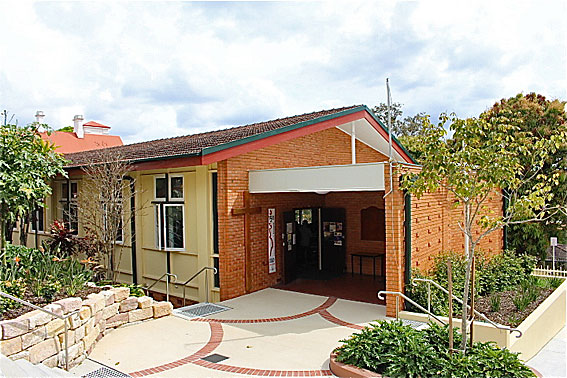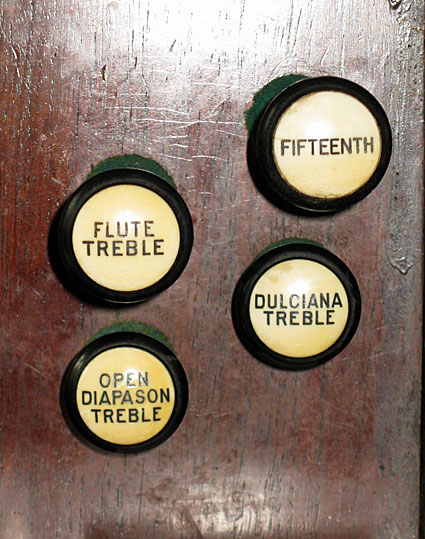
The Chapel of St Margaret's Anglican Girls' School, Ascot
[Photograph by Trevor Bunning (September 2014)]

The Chapel of St Margaret's Anglican Girls' School, Ascot
[Photograph by Trevor Bunning (September 2014)]
Historical and Technical Documentation by Geoffrey Cox
© OHTA 2011, 2014 (last updated October 2014)
The history of St Margaret's School stems from a boarding school established in Nundah in 1895 by the Sisters of the Society of the Sacred Advent. The school moved to its present location in 1910, occupying 'Donatto,' a house built in the 1880s. It was named 'St Margaret's Church of England Girls' School' a few years later. The adjoining property 'Avoca', built by Andrew Petrie in 1886, was purchased in 1918. The original chapel (now the Sisters' Chapel) was designed by Robin Dods and built in 1914. The present School Chapel was consecrated on St Margaret's Day, 20 July 1958.1

The Sisters' Chapel, St Margaret's School, Ascot, built in 1914
[Photograph by Geoffrey Cox (February 2007)]
First Organ.
The first organ at St Margaret's School had been built in 1918 by B.B. Whitehouse & Co. for St Augustine's Anglican Church, Hamilton.2 An identical instrument was built by the firm for St Mark's Anglican Church, Albion (Clayfield) in 1919, and subsequently moved to St Mary's Anglican Church, Bardon. These two were followed later by another two of similar design but of different compass from the earlier two: for St John's Anglican Church, Cairns (1927) and Zion Lutheran Church, Minden (1931).

The 1918 B.B. Whitehouse & Co. organ
photographed at St Augustine's Church, Hamilton
[Photograph from Anglican Diocese of Brisbane,
Records and Archive Centre, HAMIS063-95]
Within the context of the Whitehouse output of tubular-pneumatic organs, these instruments were distinctive in having only one manual, no pedals, completely unenclosed pipework, and employing a 'melodic bass' stop at 16ft pitch. Such melodic stops had already existed in Queensland on two organs built by the Positive Organ Co. of London, located originally at the Catholic Apostolic Church, South Brisbane (date not recorded), and Holy Trinity Anglican Church, Mackay (1890s).3 These imported instruments may have served as a model for the use of melodic stops by the Whitehouse firm.
The St Augustine's organ was moved to a new position in the church at Hamilton in August 1937, and a motor blower was installed in April 1938 at a cost of £32.4 The bellows were re-leathered in 1956, and the organ was removed from St Augustine's and installed in the new school chapel at St Margaret's in June 1958 by Whitehouse Bros.5 It was overhauled in 1992 by W.J. Simon Pierce.6
The specification of the instrument, as recorded at St Margaret's School, was as follows:
| MANUAL Bourdon Salicional Open Diapason COUPLER Octave Coupler |
16 8 8 |
(Melodic Bass) 20 notes (FF to middle C) (3 octaves)* (3 octaves)* |
Pneumatic action
Compass: F-F (4 octaves)
Totally unenclosed
No pedals.7
* the lowest octave of these two stops were Bourdon pipes, eight of which were derived from the Bourdon 16ft.
After being placed in storage at the school around 1993, the pipework of the instrument suffered irretrievable damage. The entire instrument was broken up around 1994.8
Present Organ.
The present organ was built by B.B. Whitehouse & Co. of Brisbane for the Presbyterian Church, Enoggera Terrace, Ithaca, in 1905. It was opened on Tuesday 21 November that year, when the following account was published:
NEW ORGAN AT THE ENOGGERA-
TERRACE PRESBYTERIAN CHURCH
The members of the Enoggera-terrace Presbyterian Church celebrated the installation of a new pipe organ by a recital on Tuesday evening at which the organ was greatly admired. It was manufactured and erected by Messrs. B. B. Whitehouse and Co., Brisbane. Although a one-manual organ, it has been built with three sets of pipes, so constructed that the treble (thirty-two notes) can be used independently of the bass (twenty-nine notes), thus forming a combination similar to a two-manual organ. The stops comprise the following: - Open diapason, treble 8ft., and bass 8ft.; dulciana, treble 8ft, and bass 8ft; flute, treble 4ft, and bass 4ft. There is also a superoctave coupler, which doubles the power of the organ. The blowing is done by hand. The case is of polished silky oak, and the front pipes of the organ are decorated with a suitable design in goldleaf, &c. Although the organ is complete in itself, provision has been made for the addition of new stops and a set of pedals.9
The builder's nameplate
[Photograph by Trevor Bunning (September 2014)]
It was not reported until February 1908 that the 'new organ had been paid for.'10 This was the smallest, and the earliest, of several single-manual mechanical-action organs built by the firm around this time, others being for Scots Presbyterian Church, Clayfield, and the Presbyterian Church, Toowong.


The organ for the Presbyterian Church, Ithaca (1905),
now at St Margaret's Anglican Girls' School, Ascot
[Photographs by Trevor Bunning (September 2014)]
The organ was moved from Ithaca to the Greenslopes Baptist Church in January 1934 by Whitehouse Bros at a cost of £65.11 The pitch was adjusted to concert pitch in 1942, at which time tuning slides were fitted to the metal pipes and new bottom notes were installed at a further cost of £20.12 In 1972, H.W. Jarrott added the Fifteenth 2ft on the spare slide, as well as the bottom octave of the Open Diapason 8ft.13 The organ was offered for sale at Greenslopes in 1993 and installed in its current location in 1994 by W.J. Simon Pierce.14

The Baptist Church, Greenslopes
[Photograph by Geoffrey Cox (February 2007)]
The pipework is entirely enclosed, except for the new bottom octave of the Open Diapason 8ft, which is located along the two sides of the instrument. The front pipes are non-speaking. All four stops are divided into bass and treble halves, split between e' and f' above middle c'. The stop knobs bear no pitch indications.

Console of the B.B. Whitehouse & Co. organ
[Photograph by Trevor Bunning (September 2014)]



Console details
[Photographs by Geoffrey Cox (September 2014)]
| MANUAL [compass divided at e'/f'] | ||
| Open Diapason Bass Dulciana Bass Flute Bass Fifteenth [Bass] Open Diapason Treble Dulciana Treble Flute treble Fifteenth [Treble] COUPLER [Supa Octave Coupler] |
[8] [8] [4] [2] [8] [8] [4] [2] |
[originally Ten.C or gvd bass] [stpd bass] [1972] [1972] ["ON" and "OFF" buttons above the manual] |
Balanced Swell pedal (horizontal shutters)
Mechanical action
Compass: 61 notes
Drawstop console
No pedals.15
_________________________________________________________________________
1 S. Geise & M. Laurie, Per Volar Sunata 1895-1996 (Brisbane: Boolarong Press, 1997).
2 Whitehouse Bros List.
3 The Catholic Apostolic instrument is now located in the gallery at Holy Trinity Anglican Church, Fortitude Valley. The Mackay instrument was moved to the Methodist Church, West End, in 1901, and later to St Philip's Anglican Church, Annerley.
4 Whitehouse Bros Ledger (1922-1940), p. 163.
5 Whitehouse Bros List.
6 The Organ Voice, vol. 19, no. 3 (December 1991), p. 55.
7 Specification noted by G. Cox, 1973.
8 Personal communication from W.J. Simon Pierce to G. Cox, January 2001.
9 The Brisbane Courier (25 November 1905), p. 16.
10 The Brisbane Courier (19 February 1908), p. 4.
11 Whitehouse Bros Ledger (1922-40), pp. 160, 248.
12 Whitehouse Bros Ledger (1940-54), p. 327.
13 Personal communication from H.W. Jarrott to G. Cox, 1974.
14 The Organ Voice, vol. 20, no. 2 (February 1993), p. 12; Personal communication from W.J. Simon Pierce to G. Cox, January 2001.
15 Specification noted at Greenslopes by G. Cox, 1974, and at Ascot, 2014.